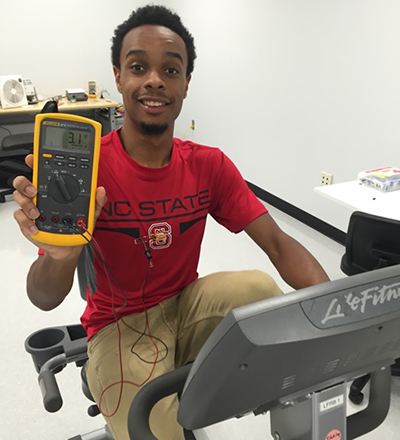Wearable electronics powered by body heat

Researchers at North Carolina State University have developed a design for harvesting body heat and converting it into electricity for use in wearable electronics. Writing in the journal Applied Energy, the study authors say their experimental prototypes can generate far more electricity than previous lightweight heat-harvesting technologies.
“Wearable thermoelectric generators (TEGs) generate electricity by making use of the temperature differential between your body and the ambient air,” said Associate Professor Daryoosh Vashaee. “Previous approaches either made use of heat sinks — which are heavy, stiff and bulky — or were able to generate only one microwatt or less of power per centimetre squared (µW/cm2). Our technology generates up to 20 µW/cm2 and doesn’t use a heat sink, making it lighter and much more comfortable.”
The new design begins with a layer of thermally conductive material that rests on the skin and spreads out the heat. The conductive material is topped with a polymer layer that prevents the heat from dissipating through to the outside air. This forces the body heat to pass through a centrally located TEG that is 1 cm2. Heat that is not converted into electricity passes through the TEG into an outer layer of thermally conductive material, which rapidly dissipates the heat. The entire system is only 2 mm thick and flexible.
“In this prototype, the TEG is only 1 cm2, but we can easily make it larger, depending on a device’s power needs,” said Associate Professor Vashaee.
The researchers also found that the upper arm was the optimal location for heat harvesting. While the skin temperature is higher around the wrist, the irregular contour of the wrist limited the surface area of contact between the TEG band and the skin. Meanwhile, wearing the band on the chest limited airflow — limiting heat dissipation — since the chest is normally covered by a shirt.
In addition, the researchers incorporated the TEG into T-shirts. The researchers found that the T-shirt TEGs were still capable of generating 6 µW/cm2 — or as much as 16 µW/cm2 if a person is running. Associate Professor Vashaee said the T-shirt TEGs are “certainly viable for powering wearable technologies, but they’re just not as efficient as the upper arm bands”.
Associate Professor Vashaee worked on the project as part of the National Science Foundation’s Nanosystems Engineering Research Center for Advanced Self-Powered Systems of Integrated Sensors and Technologies (ASSIST), the goal of which is to “make wearable technologies that can be used for long-term health monitoring”, he said.
“To do that, we want to make devices that don’t rely on batteries. And we think this design and prototype moves us much closer to making that a reality.”
Predictive AI model enhances solid-state battery design
ECU researchers are working on ways to make solid-state batteries more reliable with the help of...
Boosting performance of aqueous zinc–iodine batteries
Engineers from the University of Adelaide have enhanced aqueous zinc–iodine batteries using...
Sodium-ion battery breakthrough boosts energy storage
Scientists have discovered that leaving water inside a key material, rather than removing it,...




